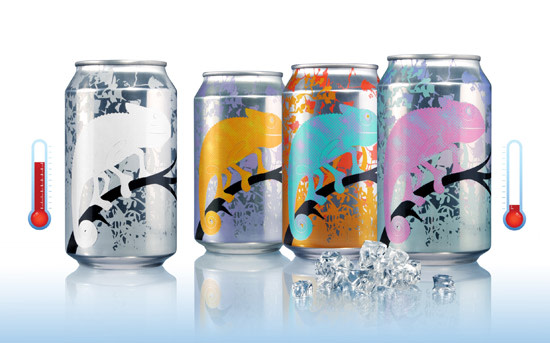 The new beverage cans from Ball Packaging Europe change color like a chameleon—shifting, say, from blue to purple or yellow to green with a change in temperature.
The new beverage cans from Ball Packaging Europe change color like a chameleon—shifting, say, from blue to purple or yellow to green with a change in temperature. Previously, the color could only be made to change from white to blue. By enhancing the thermochromic ink technology, Ball has opened up new opportunities for customers to design cans with striking color effects.
For the first time, Ball has made thermochromic ink not only change color from white to blue, but from any color to any other. The secret of thermochromic ink is held in special microcapsules. The color change is triggered when the can reaches a specific temperature. This means consumers can see when a can is still warm and when it attains the right drinking temperature. The trigger temperature can be varied.

Depending on its composition, the ink changes color at four, seven, nine or eleven degrees Celsius, so customers can set the color change signal to the ideal drinking temperature for their product. This gives them new marketing opportunities, with playful features like thermochromism in strong demand especially for dynamic markets like the energy drink sector where visual impact is important. The newly developed temperature-sensitive inks can be used for both steel and aluminum cans and are best suited for pastel tones.
Ball first launched thermochromic ink technology in 2005 when it succeeded for the first time in printing temperature-sensitive elements on beverage cans—at first restricted to the colors white and blue. This technology has since been taken up by increasing numbers of beverage producers wanting to provide enhanced convenience for consumers while highlighting the high quality of their brands. UK brewer Molson Coors, for example, uses the technology specifically in support of a marketing strategy built around the crisp refreshing taste of its premium beers.
The brewery brought out Coors Light beer brand in thermochromic cans this February. British soft drinks producer Britvic, on the other hand, uses cheeky straplines that are revealed when missing words become visible as a can cools.
Ball plans further enhancements to the ink technology. The next step is to make the starting color change to different hues on one and the same can. Cans will then take on different colors stage by stage as they change temperature.
Thermochromic printing on beverage cans provides an added benefit for consumers, further supplementing the unique advantages of cans as the container of choice. Cans are absolutely light-tight and oxygen-tight, ensure a fresh taste experience at all times and have a long shelf life. They also retain their good environmental performance: Beverage cans can be recycled infinitely without any loss in quality.


